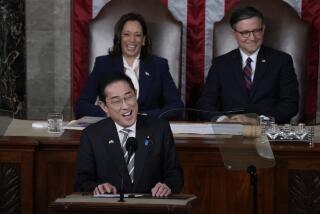Japan to Pump Up Slow Economy : But Plan Includes No Tax Cut to Boost Consumer Spending
- Share via
TOKYO — In his first major economic initiative, Prime Minister Morihiro Hosokawa on Thursday unveiled a $57-billion package of new spending, deregulation measures and consumer benefits to boost Japan’s sagging economy.
But he failed to include an income tax cut, which many economic analysts, business leaders and U.S. officials have been urging as the quickest way to stimulate consumer spending on imported goods and cut Japan’s burgeoning trade surplus. A few hours after Hosokawa’s announcement, the U.S. Commerce Department released figures showing that the U.S. trade deficit with Japan rose 9.3% in July to $4.736 billion, from $4.335 billion in June.
The growing deficit with Japan--continuing a trend of Japanese exports to the United States far outpacing U.S. exports to Japan--contrasts with a narrowing of the overall U.S. deficit in July, which fell to $10.34 billion from $12.06 billion in June.
The overall deficit reduction was a “welcomed improvement,”U.S. Commerce Secretary Ronald Brown said, but the figures also show that Japan and Europe must do more to stimulate their economies. “This is why we are reviewing the new Japanese stimulus proposal with great interest and hope that other stimulus actions in both Japan and Europe will be forthcoming,” he said in a prepared statement.
Hosokawa was modest in presenting his program on national television, using charts and a pointer.
“I don’t think this is good enough, but I believe we have done the best we could do at the moment,” he said. “I am certain this will produce some effects in itself.”
The package did produce some immediate effects--but probably not the kind he had in mind. Registering disappointment, Tokyo stock prices plunged Thursday by 445.64 points to close at 20,502.15--the second-biggest single-session fall this year. The dollar also fell to 104.62 yen, down a sharp 1.13.
“Overall, there’s disappointment all around,” said a trader with James Capel & Co. He said the market was “used to larger numbers” in pump-priming packages, in the range of $95 billion to $133 billion.
Still, Japanese officials predicted that the package will push up the gross national product by 1.3%. Despite two previous pump-priming packages--$101 billion last year and $125 billion in April--the economy has continued to limp along, weakened by the steep rise in the yen’s value and an unusually cold summer, which has harmed crops, driven up food prices and cut demand for such items as air conditioners.
The government announced this week that the economy contracted at an annual rate of 2% in the April-June quarter, leading several corporations to predict layoffs.
Officials stressed that the $57 billion in direct new spending is merely one portion of the package. Other boosters will be provided by the deregulation measures and moves to pass on to consumers the high yen’s benefit.
One official called the package merely the “first stage” in Hosokawa’s economic strategy. Additional measures are likely to come after the government concludes studies later this year on tax reform.
The package includes:
* Deregulation in 94 areas, including easier licensing for beer production and flexible taxi pricing.
* Reduction in such items as air fares, electricity and gas rates to pass on the high yen’s benefit to consumers.
* A $9.5-billion investment package to enhance the lifestyles of “ordinary people,” such as with new art museums and improvements for the handicapped.
* $9.5 billion in loans to small- and medium-sized companies.
* $4.2 billion in disaster relief aid.
* Expanded housing loans.
* Corporate tax incentives.
Bloomberg Business News contributed to this report.
A Widening Trade Deficit With Japan
The U.S. trade deficit has worsened with Japan but overall shows some improvement. Figures in billions of dollars:
U.S. Trade Deficit With Japan
July, 1993: $4.7 billion
July, 1991: $3.8 billion
Top Exports From Japan to U.S.
Top Japanese exports to the U.S. for the first half of 1993, and change from the same period last year:
Export Amount Change Automobiles $10.86 +2.8% Computers 6.50 +20.4% Auto parts 3.13 +15.7% Precision tools 2.54 +5.1% Auto engines 1.87 +39.0% Chemicals 1.76 +10.7% Metals and metal products 1.68 -7.2% VCR’s and visual equipment 1.47 -5.7% Communications equipment 1.27 +12.2% Semiconductors 1.27 +21.7%
Overall U.S. Merchandise Trade Deficit
July, 1993: $10.3 billion
July, 1991: $5.5 billion
Sources: Commerce Department; International Trade Reporter
Researched by ADAM S. BAUMAN / Los Angeles Times
More to Read
Inside the business of entertainment
The Wide Shot brings you news, analysis and insights on everything from streaming wars to production — and what it all means for the future.
You may occasionally receive promotional content from the Los Angeles Times.











